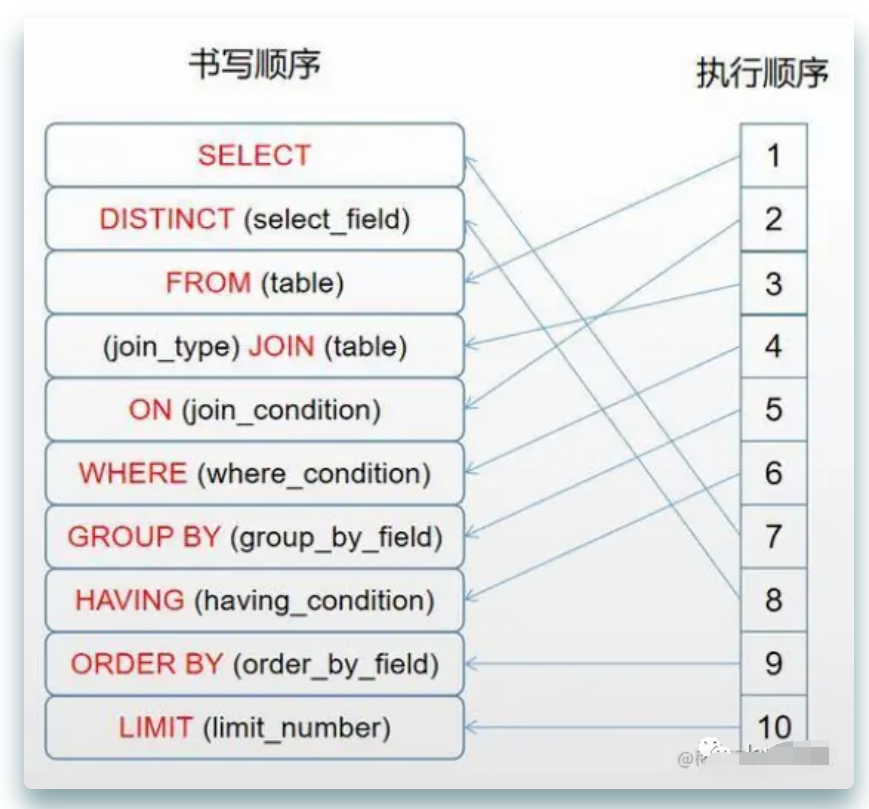8种专坑同事的 SQL 写法,性能降低100倍,不来看看?
 程序员的成长之路互联网/程序员/技术/资料共享
关注
程序员的成长之路互联网/程序员/技术/资料共享
关注
阅读本文大概需要 14 分钟。
来自: developer.aliyun.com/article/72501
今天给大家分享几个SQL常见的“坏毛病”及优化技巧。SQL语句的执行顺序:
 图片
图片1、LIMIT 语句
分页查询是最常用的场景之一,但也通常也是最容易出问题的地方。比如对于下面简单的语句,一般 DBA 想到的办法是在 type、 name、 create_time 字段上加组合索引。这样条件排序都能有效的利用到索引,性能迅速提升。
SELECT *
FROM operation
WHERE type = 'SQLStats'
AND name = 'SlowLog'
ORDER BY create_time
LIMIT 1000, 10;
LIMIT 1000000,10” 时,程序员仍然会抱怨:我只取10条记录为什么还是慢?要知道数据库也并不知道第1000000条记录从什么地方开始,即使有索引也需要从头计算一次。出现这种性能问题,多数情形下是程序员偷懒了。在前端数据浏览翻页,或者大数据分批导出等场景下,是可以将上一页的最大值当成参数作为查询条件的。SQL 重新设计如下:
SELECT *
FROM operation
WHERE type = 'SQLStats'
AND name = 'SlowLog'
AND create_time > '2017-03-16 14:00:00'
ORDER BY create_time limit 10;
2、隐式转换
SQL语句中查询变量和字段定义类型不匹配是另一个常见的错误。比如下面的语句:
mysql> explain extended SELECT *
> FROM my_balance b
> WHERE b.bpn = 14000000123
> AND b.isverified IS NULL ;
mysql> show warnings;
| Warning | 1739 | Cannot use ref access on index 'bpn' due to type or collation conversion on field 'bpn'
varchar(20),MySQL 的策略是将字符串转换为数字之后再比较。函数作用于表字段,索引失效。上述情况可能是应用程序框架自动填入的参数,而不是程序员的原意。现在应用框架很多很繁杂,使用方便的同时也小心它可能给自己挖坑。3、关联更新、删除
虽然 MySQL5.6 引入了物化特性,但需要特别注意它目前仅仅针对查询语句的优化。对于更新或删除需要手工重写成 JOIN。比如下面 UPDATE 语句,MySQL 实际执行的是循环/嵌套子查询(DEPENDENT SUBQUERY),其执行时间可想而知。
UPDATE operation o
SET status = 'applying'
WHERE o.id IN (SELECT id
FROM (SELECT o.id,
o.status
FROM operation o
WHERE o.group = 123
AND o.status NOT IN ( 'done' )
ORDER BY o.parent,
o.id
LIMIT 1) t);
+----+--------------------+-------+-------+---------------+---------+---------+-------+------+-----------------------------------------------------+
| id | select_type | table | type | possible_keys | key | key_len | ref | rows | Extra |
+----+--------------------+-------+-------+---------------+---------+---------+-------+------+-----------------------------------------------------+
| 1 | PRIMARY | o | index | | PRIMARY | 8 | | 24 | Using where; Using temporary |
| 2 | DEPENDENT SUBQUERY | | | | | | | | Impossible WHERE noticed after reading const tables |
| 3 | DERIVED | o | ref | idx_2,idx_5 | idx_5 | 8 | const | 1 | Using where; Using filesort |
+----+--------------------+-------+-------+---------------+---------+---------+-------+------+-----------------------------------------------------+
DEPENDENT SUBQUERY 变成 DERIVED,执行速度大大加快,从7秒降低到2毫秒。
UPDATE operation o
JOIN (SELECT o.id,
o.status
FROM operation o
WHERE o.group = 123
AND o.status NOT IN ( 'done' )
ORDER BY o.parent,
o.id
LIMIT 1) t
ON o.id = t.id
SET status = 'applying'
+----+-------------+-------+------+---------------+-------+---------+-------+------+-----------------------------------------------------+
| id | select_type | table | type | possible_keys | key | key_len | ref | rows | Extra |
+----+-------------+-------+------+---------------+-------+---------+-------+------+-----------------------------------------------------+
| 1 | PRIMARY | | | | | | | | Impossible WHERE noticed after reading const tables |
| 2 | DERIVED | o | ref | idx_2,idx_5 | idx_5 | 8 | const | 1 | Using where; Using filesort |
+----+-------------+-------+------+---------------+-------+---------+-------+------+-----------------------------------------------------+
4、混合排序
MySQL 不能利用索引进行混合排序。但在某些场景,还是有机会使用特殊方法提升性能的。
SELECT *
FROM my_order o
INNER JOIN my_appraise a ON a.orderid = o.id
ORDER BY a.is_reply ASC,
a.appraise_time DESC
LIMIT 0, 20
+----+-------------+-------+--------+-------------+---------+---------+---------------+---------+-+
| id | select_type | table | type | possible_keys | key | key_len | ref | rows | Extra
+----+-------------+-------+--------+-------------+---------+---------+---------------+---------+-+
| 1 | SIMPLE | a | ALL | idx_orderid | NULL | NULL | NULL | 1967647 | Using filesort |
| 1 | SIMPLE | o | eq_ref | PRIMARY | PRIMARY | 122 | a.orderid | 1 | NULL |
+----+-------------+-------+--------+---------+---------+---------+-----------------+---------+-+
由于 is_reply 只有0和1两种状态,我们按照下面的方法重写后,执行时间从1.58秒降低到2毫秒。
SELECT *
FROM ((SELECT *
FROM my_order o
INNER JOIN my_appraise a
ON a.orderid = o.id
AND is_reply = 0
ORDER BY appraise_time DESC
LIMIT 0, 20)
UNION ALL
(SELECT *
FROM my_order o
INNER JOIN my_appraise a
ON a.orderid = o.id
AND is_reply = 1
ORDER BY appraise_time DESC
LIMIT 0, 20)) t
ORDER BY is_reply ASC,
appraisetime DESC
LIMIT 20;
5、EXISTS语句
MySQL 对待 EXISTS 子句时,仍然采用嵌套子查询的执行方式。如下面的 SQL 语句:
SELECT *
FROM my_neighbor n
LEFT JOIN my_neighbor_apply sra
ON n.id = sra.neighbor_id
AND sra.user_id = 'xxx'
WHERE n.topic_status < 4
AND EXISTS(SELECT 1
FROM message_info m
WHERE n.id = m.neighbor_id
AND m.inuser = 'xxx')
AND n.topic_type <> 5
+----+--------------------+-------+------+-----+------------------------------------------+---------+-------+---------+ -----+
| id | select_type | table | type | possible_keys | key | key_len | ref | rows | Extra |
+----+--------------------+-------+------+ -----+------------------------------------------+---------+-------+---------+ -----+
| 1 | PRIMARY | n | ALL | | NULL | NULL | NULL | 1086041 | Using where |
| 1 | PRIMARY | sra | ref | | idx_user_id | 123 | const | 1 | Using where |
| 2 | DEPENDENT SUBQUERY | m | ref | | idx_message_info | 122 | const | 1 | Using index condition; Using where |
+----+--------------------+-------+------+ -----+------------------------------------------+---------+-------+---------+ -----+
SELECT *
FROM my_neighbor n
INNER JOIN message_info m
ON n.id = m.neighbor_id
AND m.inuser = 'xxx'
LEFT JOIN my_neighbor_apply sra
ON n.id = sra.neighbor_id
AND sra.user_id = 'xxx'
WHERE n.topic_status < 4
AND n.topic_type <> 5
+----+-------------+-------+--------+ -----+------------------------------------------+---------+ -----+------+ -----+
| id | select_type | table | type | possible_keys | key | key_len | ref | rows | Extra |
+----+-------------+-------+--------+ -----+------------------------------------------+---------+ -----+------+ -----+
| 1 | SIMPLE | m | ref | | idx_message_info | 122 | const | 1 | Using index condition |
| 1 | SIMPLE | n | eq_ref | | PRIMARY | 122 | ighbor_id | 1 | Using where |
| 1 | SIMPLE | sra | ref | | idx_user_id | 123 | const | 1 | Using where |
+----+-------------+-------+--------+ -----+------------------------------------------+---------+ -----+------+ -----+
6、条件下推
外部查询条件不能够下推到复杂的视图或子查询的情况有:- 聚合子查询;
- 含有 LIMIT 的子查询;
- UNION 或 UNION ALL 子查询;
- 输出字段中的子查询;
SELECT *
FROM (SELECT target,
Count(*)
FROM operation
GROUP BY target) t
WHERE target = 'rm-xxxx'
+----+-------------+------------+-------+---------------+-------------+---------+-------+------+-------------+
| id | select_type | table | type | possible_keys | key | key_len | ref | rows | Extra |
+----+-------------+------------+-------+---------------+-------------+---------+-------+------+-------------+
| 1 | PRIMARY | <derived2> | ref | <auto_key0> | <auto_key0> | 514 | const | 2 | Using where |
| 2 | DERIVED | operation | index | idx_4 | idx_4 | 519 | NULL | 20 | Using index |
+----+-------------+------------+-------+---------------+-------------+---------+-------+------+-------------+
SELECT target,
Count(*)
FROM operation
WHERE target = 'rm-xxxx'
GROUP BY target
+----+-------------+-----------+------+---------------+-------+---------+-------+------+--------------------+
| id | select_type | table | type | possible_keys | key | key_len | ref | rows | Extra |
+----+-------------+-----------+------+---------------+-------+---------+-------+------+--------------------+
| 1 | SIMPLE | operation | ref | idx_4 | idx_4 | 514 | const | 1 | Using where; Using index |
+----+-------------+-----------+------+---------------+-------+---------+-------+------+--------------------+
- http://mysql.taobao.org/monthly/2016/07/08
7、提前缩小范围
先上初始 SQL 语句:
SELECT *
FROM my_order o
LEFT JOIN my_userinfo u
ON o.uid = u.uid
LEFT JOIN my_productinfo p
ON o.pid = p.pid
WHERE ( o.display = 0 )
AND ( o.ostaus = 1 )
ORDER BY o.selltime DESC
LIMIT 0, 15
+----+-------------+-------+--------+---------------+---------+---------+-----------------+--------+----------------------------------------------------+
| id | select_type | table | type | possible_keys | key | key_len | ref | rows | Extra |
+----+-------------+-------+--------+---------------+---------+---------+-----------------+--------+----------------------------------------------------+
| 1 | SIMPLE | o | ALL | NULL | NULL | NULL | NULL | 909119 | Using where; Using temporary; Using filesort |
| 1 | SIMPLE | u | eq_ref | PRIMARY | PRIMARY | 4 | o.uid | 1 | NULL |
| 1 | SIMPLE | p | ALL | PRIMARY | NULL | NULL | NULL | 6 | Using where; Using join buffer (Block Nested Loop) |
+----+-------------+-------+--------+---------------+---------+---------+-----------------+--------+----------------------------------------------------+
my_order排序提前缩小数据量再做左连接。SQL 重写后如下,执行时间缩小为1毫秒左右。
SELECT *
FROM (
SELECT *
FROM my_order o
WHERE ( o.display = 0 )
AND ( o.ostaus = 1 )
ORDER BY o.selltime DESC
LIMIT 0, 15
) o
LEFT JOIN my_userinfo u
ON o.uid = u.uid
LEFT JOIN my_productinfo p
ON o.pid = p.pid
ORDER BY o.selltime DESC
limit 0, 15
select_type=DERIVED)参与 JOIN。虽然估算行扫描仍然为90万,但是利用了索引以及 LIMIT 子句后,实际执行时间变得很小。
+----+-------------+------------+--------+---------------+---------+---------+-------+--------+----------------------------------------------------+
| id | select_type | table | type | possible_keys | key | key_len | ref | rows | Extra |
+----+-------------+------------+--------+---------------+---------+---------+-------+--------+----------------------------------------------------+
| 1 | PRIMARY | <derived2> | ALL | NULL | NULL | NULL | NULL | 15 | Using temporary; Using filesort |
| 1 | PRIMARY | u | eq_ref | PRIMARY | PRIMARY | 4 | o.uid | 1 | NULL |
| 1 | PRIMARY | p | ALL | PRIMARY | NULL | NULL | NULL | 6 | Using where; Using join buffer (Block Nested Loop) |
| 2 | DERIVED | o | index | NULL | idx_1 | 5 | NULL | 909112 | Using where |
+----+-------------+------------+--------+---------------+---------+---------+-------+--------+----------------------------------------------------+
8、中间结果集下推
再来看下面这个已经初步优化过的例子(左连接中的主表优先作用查询条件):
SELECT a.*,
c.allocated
FROM (
SELECT resourceid
FROM my_distribute d
WHERE isdelete = 0
AND cusmanagercode = '1234567'
ORDER BY salecode limit 20) a
LEFT JOIN
(
SELECT resourcesid, sum(ifnull(allocation, 0) * 12345) allocated
FROM my_resources
GROUP BY resourcesid) c
ON a.resourceid = c.resourcesid
SELECT a.*,
c.allocated
FROM (
SELECT resourceid
FROM my_distribute d
WHERE isdelete = 0
AND cusmanagercode = '1234567'
ORDER BY salecode limit 20) a
LEFT JOIN
(
SELECT resourcesid, sum(ifnull(allocation, 0) * 12345) allocated
FROM my_resources r,
(
SELECT resourceid
FROM my_distribute d
WHERE isdelete = 0
AND cusmanagercode = '1234567'
ORDER BY salecode limit 20) a
WHERE r.resourcesid = a.resourcesid
GROUP BY resourcesid) c
ON a.resourceid = c.resourcesid
WITH a AS
(
SELECT resourceid
FROM my_distribute d
WHERE isdelete = 0
AND cusmanagercode = '1234567'
ORDER BY salecode limit 20)
SELECT a.*,
c.allocated
FROM a
LEFT JOIN
(
SELECT resourcesid, sum(ifnull(allocation, 0) * 12345) allocated
FROM my_resources r,
a
WHERE r.resourcesid = a.resourcesid
GROUP BY resourcesid) c
ON a.resourceid = c.resourcesid
总结
数据库编译器产生执行计划,决定着SQL的实际执行方式。但是编译器只是尽力服务,所有数据库的编译器都不是尽善尽美的。上述提到的多数场景,在其它数据库中也存在性能问题。了解数据库编译器的特性,才能避规其短处,写出高性能的SQL语句。程序员在设计数据模型以及编写SQL语句时,要把算法的思想或意识带进来。编写复杂SQL语句要养成使用 WITH 语句的习惯。简洁且思路清晰的SQL语句也能减小数据库的负担 。<END>
推荐阅读:
互联网初中高级大厂面试题(9个G)
内容包含Java基础、JavaWeb、MySQL性能优化、JVM、锁、百万并发、消息队列、高性能缓存、反射、Spring全家桶原理、微服务、Zookeeper......等技术栈!
⬇戳阅读原文领取!
朕已阅
![]()
